HIT CHANNEL EXCLUSIVE INTERVIEW: August 2018. We had the great to honour to talk with a legendary musician: Randy Bachman. He is best known as the lead guitarist, founding member and composer of The Guess Who and Bachman-Turner Overdrive (BTO). He wrote or co-wrote many hit singles, including “American Woman”, “You Ain’t Seen Nothing Yet”, “These Eyes” and “Undun”. Earlier this year, he released his latest studio album, “By George – By Bachman”, a tribute to the Beatles guitarist, George Harrison. Read below the very interesting things Randy told us:
 How difficult was it to re-imagine George Harrison’s songs in a different way, for your latest album “By George – By Bachman”?
How difficult was it to re-imagine George Harrison’s songs in a different way, for your latest album “By George – By Bachman”?
Well, it was quite difficult because I thought George Harrison’s arrangements and The Beatles arrangements were perfect, so to the rest of world. I mean, they were hits all over the world. So, to get them and reinvent them, so to speak, was quite difficult. Each song had 4, 5 or 6, some had 10 different arrangements, chord progressions, tempos and rhythm things behind it. Finally, I got some that were comfortable, that I could sing and that will still remind you of the original, that the minute you got over the tempo and the new chords, you can sing along with it. It was a very enjoyable, wonderful experience to do that. It was tough, but you know, if something is tough and you enjoy doing it, it’s not that tough.
What is the meaning of the song “Between Two Mountains”, the only original of the album?
The original idea was: I tried to imagine what it could be like if I was George Harrison and showed up to a Beatles session with John Lennon having 25 songs and Paul McCartney having 20 songs (songs). When they were all done with the Lennon and McCartney songs, they might say: “Hey George, do you have a song?” and I would say, if I was George: “Yes, I have a song called ‘Taxman’, ‘Here Comes the Sun’ or ‘Something’” and then they would do the song. Rather than being bitter and angry at these guys, I say in the lyrics: “I learned to wait/ My time will come/I celebrate ‘cause I’m the one/ Between two mountains”. And when the two mountains ran out, they left space. They were the main creative force of The Beatles, but right there, in the minute they had a hesitation or a little difficulty with their creativity, there was George and there were his songs. So, that’s what it means. He was there waiting peacefully and when his time came, he became his own mountain. He stood up between these two mountains, with his own mountain. Then, the second verse of the song is about us and our lives born into this world and you have Mount Good and Mount Evil and you choose which one you gonna live under. If you choose the wrong mountain you gonna come back and rethink what you are doing. So, that’s the evidence behind this song.
Are you satisfied with the response you got from fans during the tour for “By George –By Bachman”?
The fans were amazed. They have a wonderful time. They buy the album or the CD, they drive around in a car, with their friends, they play the album and they try to guess what song it is, because they don’t know what it is. All The Beatles songs have such distinctive guitar intros and stuff and you can tell what it was right away. Mine are different distinctive guitar intros and they start into the song and they don’t know what it is. When I start singing, they can sing along. The song would start and when they find out that this is “You Like Me Too Much” or “Taxman” or whatever, they’d all say: “It’s so different. We really love it”, which is fantastic. So, The Beatles fans really liked it. A lot of them said they listened to The Beatles Sirius XM Channel all the time, 24 hours a day and it just gets a little tiring hearing the same Beatles versions, over and over again. And they hear these new versions of songs and it’s very exciting and refreshing thing for them on songs they really know and like. So, in other words, I get to play somebody else’s greatest hits on the radio.
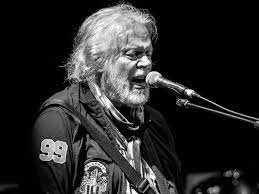 Was Walter Trout an obvious choice for the amazing solo on “While My Guitar Gently Weeps”?
Was Walter Trout an obvious choice for the amazing solo on “While My Guitar Gently Weeps”?
I met Walter Trout at the Jeff Healey 50th Birthday Party reunion. Jeff Healey had passed away, but we were celebrating his 50th birthday and that was in Toronto, at Massey Hall. So, I went there along with Sonny Landreth, Philip Sayce, who played with Jeff Healey for many years and Walter Trout. We were all there doing our own songs and we jammed at the end and Walter Trout came and he expressed that he was a fan of mine and I told Walter that I was a fan of his and he said: “Let’s do something together”. He had done an album, his last blues album (ed: “We’re All In This Together” -2017), he sent me a track and I sang it with him and played guitar on it with him and then it came out and went into No.1 of the Billboard Blues charts, that particular song on the album (ed: “Got Nothin’ Left”). So, I was doing this album and I thought that I really need something special in one of the guitar songs, either in “While My Guitar Gently Weeps” or in “Taxman”. I sent him both and he sent me “While My Guitar Gently Weeps” and it was just incredible. I kept every note that he played and it was fantastic!
I’m a big fan of your previous album, “Heavy Blues” (2015). Did you feel comfortable playing that kind of music as a three piece?
Although it was a one-off for me, I loved playing on it. I’m a fan of that, because that is really a guitar/guitarist album. I wrote every song to be really bluesy rock. The people on it were two women on drums (ed: Dale Anne Brendan) and bass (ed: Anna Ruddick), who played incredibly. I had guest guitar players like Scott Holiday (Rival Sons), Neil Young, Jeff Healey, Peter Frampton, Robert Randolph, Luke Doucet, Joe Bonamassa. It was really a treat and I still think it’s very popular. I still play a lot of the songs live. I lot of fans yell out for them when I am playing live. There is so much material, I can’t play it all. Every night somebody yells out: “Play something from ‘Heavy Blues’”! I play “Heavy Blues” or “Wild Texas Ride”, “Ton of Bricks” or something like that. We do it all.
Did you expect the huge commercial success of the song “American Woman” (1969)?
When you record a song you always hope for the best, but you have no idea if radio would play it. If radio doesn’t play it, then the fans still don’t know it’s out there. They don’t buy it. I think one my best songs it’s “Between Two Mountains”. If radio doesn’t play it, the fans aren’t gonna know it’s out there. A lot of DJ’s, a lot of George Harrison fans call me saying: “Where did you find this George Harrison song? It’s fantastic!” I would say: “It’s not a George song, I wrote is as if I was George” and they ‘d all go: “Oh, it’s amazing”! So, if the radio doesn’t play, the fans don’t know it’s out there. I am depending on guys like you who put it in an article on the Internet saying: “This is a great song. It’s like George would have felt. It sounds like George wrote it or Randy co-wrote it with the ghost of George”, which is what I did one night -and that was the night I got to write the song- feeling George’s presence in the room and it was a very amazing, spiritual trip for me. I thought it was his approval on it.
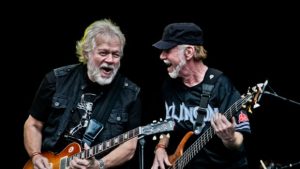 How important was the role of the producer Jack Richardson to the career of The Guess Who?
How important was the role of the producer Jack Richardson to the career of The Guess Who?
He was the core of the band. Wait. Jack Richardson was a lot like George Martin. We would come in with pretty much the finished song and he might suggest changes in the arrangement, because it was too long. Because if you don’t get your song on the radio, nobody knows it’s out there. Especially in old days when there were singles. If you didn’t have a single for the radio, nobody knew you had a record out. So, you had to cut it out to 3:00, 3:30. When we showed up a song which was too long, the producer would say: “Cut out this verse, ‘cause you are repeating it anyway or cut this chorus at half or leave all the guitar solos right to the ending”. If one band had longer album tracks with electric guitar solos, you had to edit them for radio. If you didn’t edit it for radio, radio would do their own edit and every city would have a different version of your songs. You had to do your own radio edit of the song, under 3:30, under 3:40, when your album track was 4:30-5:00 minutes long.
What was your musical vision when you formed Bachman-Turner Overdrive in 1973?
My vision was to not starve. I had left The Guess Who, they were the No.1 band in the world, No.1 album and single and tried to make my own music that didn’t sound close to The Guess Who and make my own sound. Basically, I financed the band, I produced the band, I tried everything. I just kept trying everything. I realized what rock ‘n’ roll was all about and went back to the old American Bandstand and the old juke band joints like Chuck Berry and Muddy Waters played. It was all juke joints that people got up and danced. So, I started to play heavy rock music that people would dance to. Then, I came to write “Takin’ Care of Business” and “You Ain’t Seen Nothing Yet”. Here we were and people were dancing. Somewhere to that era, there were the Creedence Clearwater Revival, everybody danced to “Proud Mary” and Rolling Stones’ “Jumpin’ Jack Flash”. It was a really great era for rock ‘n’ roll, everybody was dancing. As far as I am concerned, I think BTO played really good music, they had a great beat, everyone would dance to, everyone would sing along in the choruses, and made them happy.
What was it like to be in the same band with Ringo Starr in 1995?
That was kind of surreal, it was unreal. It was like a dream come true. I remember I was watching PBS in the States, which is Public Broadcasting and they always have a weekend on where they play old movies and old doo-wop groups and then they ask the subscribers of the station to pledge money, right to keep the station going, because it has no commercials. So, I watched a PBS weekend where they played “Help!” (1965), “A Hard Day’s Night” (1964), “Magical Mystery Tour” (1967) over and over, for three days, getting people to pledge in. And after that was all done, the next morning I was sitting in my house and my phone rings and a voice says (ed: mimics deep voice): “Boy, this is Ringo Starr. I want to play in my band” and I hung up. I thought it was my manager calling me, joking. And then the phone rang again. “Hello, this is Ringo. I’m calling from Monica. I will give you my number to call me back. It’s really me”. And so I thought: “Oh, my god! This is Ringo Starr. He wanted me to be in his band”. I said “Yes” and I toured with him for 10 months. So, I joined him and Zak (ed: Starkey –The Who), his son, on drums, Billy Preston (ed: keyboards), Mark Farner (ed: Grand Funk Railroad –guitar, vocals) and Felix Cavaliere (The Rascals –vocals, organ, keyboards). It was just an amazing time in my life.
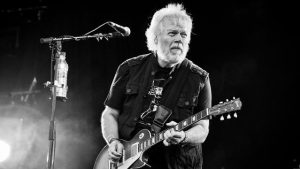 Did you enjoy the reunion of the classic line-up of The Guess Who in 1999 for the Pan American Games?
Did you enjoy the reunion of the classic line-up of The Guess Who in 1999 for the Pan American Games?
Yes, because we all had different agendas, different careers and we weren’t really speaking to each other. Something like a guy who was in a soccer team or a hockey team and you were teammates and he gets traded. With every team he gonna come back and play games, you wanna beat him. When you are in a band together and you break up, you wanna beat these guys, doing your own thing or with a different band. So, we all had different agendas. To get called by the Mayor of the city of Winnipeg and the producer of the Pan Am Games and the Premier of the province of Manitoba saying: “Please get back together. You are Winnipeg’s, Manitoba’s biggest export to the world. The whole world really wants you to play four songs”. We thought about it really hard and we decided that we want to pass our band into posterity. We would play, because we had played the Pan American Games many-many years before that, in Winnipeg, the same songs. Except that when we played them, the first time, we were in a tent, and they were feeding the athletes in a big food line -you know like in jail, the line up, it was a big food line- for just the staff and the players. We were playing the same songs and no-one paid any attention to it. And here we are, years and years later, they asked us to play the same four songs and the whole world knows the songs and all the athletes were there clapping, spinning, dancing to the songs. So, it was quite a triumph to be there and that’s why we did it.
Were you surprised when they asked you to make a guest appearance on The Simpsons in 2000?
Yes, I was pretty surprised. I was sitting at home –that was before computers, there was a fax machine- and a thing was out of my fax machine, saying: “There is a request to use your two songs “Takin’ Care of Business” and “You Ain’t Seen Nothin’ Yet” on The Simpsons”. There was a phone number. So, I phoned the phone number and I said: “Why do you want to use these songs? What’s going on?” They said: “Oh, we didn’t tell you. We are cartooning you on the show. We are cartooning Bachman-Turner Overdrive, BTO. We are going to do a cartoon of you and a cartoon of Turner and the band playing and we want to use the songs”. I said: “Wow!” Someone did a sketch and sent it over the fax machine. It was wonderful. So, then I flew to L.A and did my voice and Fred Turner (ed: vocals, bass) flew and did his voice and the cartoon was another highlight of my life.
What was it like to play at Toronto Rocks festival in 2003 with the Rolling Stones, AC/DC and Rush?
That was amazing. I think it was one of the largest pay for pop festivals. There were 500.000 people there. It was a beautiful summer day. The stage was maybe 15-18 ft high. I was 60, so my eyes read about 20 ft high level, so to be on stage and to look as far as I can see to the horizon, straight ahead of me and all the way to the right and all the way to the left and see nothing but people, clapping, spinning and having fun in a beautiful sunny day, it was amazing! And to be in a live show with Rush and AC/DC and then The Stones! We have a picture taken after, with all of us together in a room and it was like a very memorable experience. We did “American Woman” and the crowd went crazy. I did my song “Takin’ Care of Business”. It was the best most highlighted concert of my life.
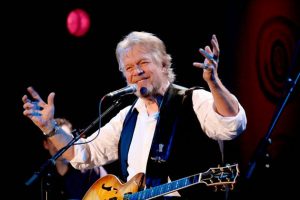 What memories do you have of your tours with Frank Zappa? He even wanted to buy your ’59 Les Paul you used on “American Woman”!
What memories do you have of your tours with Frank Zappa? He even wanted to buy your ’59 Les Paul you used on “American Woman”!
Oh, the time Frank Zappa played the ’59 Les Paul, I didn’t realize what mine was. This was about 1968. We were touring with Frank Zappa, The Mothers and Alice Cooper was the opening act, who Frank discovered him -he really discovered Alice Cooper, he was cutting his first demos- and every night the hour we would do a soundcheck, Frank would come and say: “Can I play a guitar?” and we said: “Sure, you can play the guitar”. He would say: “May I go and buy this guitar? I can give you 300 bucks”. “No, no, no”. “I am gonna buy this guitar. I can give you 350 dollars”. “No, no, no”. The guitar that Frank Zappa wanted, that I played, then it became the sound of “American Woman” and “No Time” in The Guess Who and a lot of the sound of the early BTO. Then, I realized that if you give me 130 this year, for three years, it will make 400 in the whole world. Now, its value is over a million dollars and it’s in the Rock ‘N’ Roll Museum in Calgary, Alberta.
Brian May (Queen) gave you a signed Black ‘n’ Gold Special in 2014. How did it happen?
I know Brian May since the ‘70s. I was at Disneyland, with my children, in line, it was a small roll, and my son who was about 13 at the time, Tal, he’s now in by band. I looked in the line-up, ‘cause the line zigzags and there was Brian May holding a little girl in his arms. We had the same agent, Howard Rose. Howard Rose was the agent for Elton John, me and Queen. He had three acts. So, I went to Brian May. They had like two albums out at the time: “Hi Brian, I’m Randy Bachman from BTO. We’re in the same camp” and all that stuff. We went to do a small talk after all with our kids and every time he would do a concert, I would drive by to say “Hi” to him. I’ve seen him many times with Freddie Mercury. Then I saw him at the O2 in London with Paul Rodgers and I’ve seen him about 6 times with Adam Lambert, they were quite amazing. He was touring in Canada maybe 4 years ago with Adam Lambert and I called him up.
Actually, I went to one of the shows with Paul Rodgers at the O2 and I was backstage, having dinner with Paul and Brian came up and said “Hi”. He sat down and I had a dinner with him and Brian talked about his guitar, the Red Special. I went to see “We Will Rock You” about 3, 4 or 5 times. I love the musical. I noticed in the end of the musical the guys come out and one plays a white (ed: BMG –Brian May Guitar Special) and Brian May was playing a black one and I expressed admiration for and he gave me a black one. That picture I think it was big in Winnipeg, my hometown, when Queen played and Brian gave me that signed for me. There is a picture somewhere in the website. I just saw him last month. I was in London last month and I saw him in O2 with Adam Lambert and they were fantastic. They did new songs from the new album, which are just fantastic and he is one of the great all-time original guitar players and guitar sounds. Nobody sounds like him and nobody plays like him. Anybody who does, is a copycat. He originated that sound and that style of playing which is such a strange mixture of classical and blues riffs and very melodic string epics, (ed: like) playing violin or cello or something.
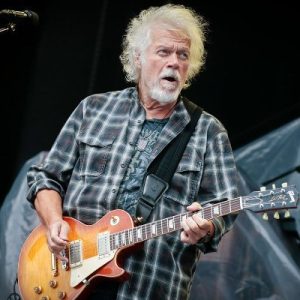 What was your reaction when you watched Lester Bangs (Philip Seymour Hoffman) in the film “Almost Famous” saying: “Give me The Guess Who. They got the courage to be drunken buffoons, which makes them poetic”.
What was your reaction when you watched Lester Bangs (Philip Seymour Hoffman) in the film “Almost Famous” saying: “Give me The Guess Who. They got the courage to be drunken buffoons, which makes them poetic”.
Right. I was really surprised. A lot of times you don’t know your music is in a movie. Because you are on the road, you are on tour, you are on vacation, your publisher or your manager doesn’t inform you. So, I have been sitting in a lot of movies with my kids and suddenly my song comes along or they mention The Guess Who or BTO, and I’m totally stunned that I go back to my room and make a phone call: “Oh, my song is in this movie!” or “They mention us it in this movie”. They go: “Oh, we did that deal last year. We thought you knew about this”. It always happens this way.
Do you believe that popular music which was written in the ‘60s and ‘70s is much better than today’s music?
Yes, way better. In the ‘60s and ‘70s we had great songwriters. If you look at the Billboard, there were Carole King & Gerry Goffin, Burt Bacharach & Hal David, Lennon & McCartney, Jagger & Richards and Brian Wilson. The music was written by songwriters who were inventing pop music. Even going back to Chuck Berry and Bo Diddley, they were inventing pop music and now everything is just a copy of that. It’s almost like art or fashion: There is nothing new. They go to a new art show or a fashion show of clothing and they go: “This is rental from the ‘30s” and they copy everything from the ‘30s. “This is from the ‘60s” and they copy everything from the ‘60s, like hippie stuff. They just recycle everything for a new generation. New people recycle from the old age, but it’s a repetition. Every 20 years everything repeats and so the music that there is out now, I don’t think it’s very inspirational. It’s all very computerized, everything is perfect and nobody likes perfect. Everybody likes imperfect stuff. Actually, people now on TV, on quiz shows were asked: “What’s your hobby? What do you like to do?” and they say: “We like to go to see live music”. I think: “Wow!!! That’s just like the ‘50s and ‘60s”. The music was on the radio, but you actually went to see the band play. Now, when you are talking about live music, you are talking about jazz and classic rock. It’s not the new EDM stuff or dance music. It’s all computerized, you can get it on your computer at home. They want to see real guys play. They want to see Steve Winwood, Eric Clapton, the Beach Boys and Queen. They want to see real guys playing real songs.
Do you think social media like Youtube and Facebook have helped younger listeners to learn about the music of The Guess Who and BTO?
Oh, that’s true. The thing about that media is that it allows a greater access to all the young kids and now with iTunes, they can buy them. Because a lot of music of that era was on the radio before you could buy it. Now that there is digital, and there is Youtube, Amazon and Spotify, the young kids can get the music. I have many grandchildren. My young granddaughter, who is 13, the other day we were in the car and we go swimming every day. We were just back from swimming or driving her for swimming. She said: “Do you want to hear my playlist?” and I said: “Sure” and she puts it on and it’s The Zombies. I said: “Wow! I know all these songs. I know these guys” and I am singing along. She was going: “Wow! This is it. I saw one of the songs on a movie, I googled it and my favourite band is The Zombies”. I asked: “Have you heard of The Kinks?” and she said: “Yes”. She played “Dedicated Follower of Fashion” and “Waterloo Sunset”. I was: “Wow!” This young teenager is discovering these great writers and the bands from the ‘60s, where everything was live on the floor. There was one microphone for playing and singing.
 Do you have any musical ambitions left?
Do you have any musical ambitions left?
Yeah, my musical ambitions will never die. I still have ambitions. I have got a plan to make an album soon with my son, Tal. My son, Tal, had a big hit about 18 or 19 years ago, called “She’s So High”. If you Google “Tal Bachman”, it gives “She’s So High”. He does it in my set now and it’s so good to be in my band and also to George Harrison’s songs ,’cause some of the songs -you hear it on the record tape- have a dual slide guitar, so he plays slide with another guitar player who plays slide and I play George’s rhythm in the middle. Then, he has some rockin’ singings in the band. So, I might do an album with me and him, called “Bachman & Bachman”. He had cut his songs. Maybe one song of his, and one of mine and a third that we write together and will put it for fun, so people will see the father/son connection. Because nobody has done an album like that. Leonard Cohen or Stephen Stills or anybody whose son is in it, hasn’t really done a father/son album, to my knowledge. So, it will be a father/son “Bachman & Bachman”.
I am huge fan of another Canadian guitarist, Frank Marino (Mahogany Rush). Do you know him?
Yes, I know him very well.
I think he’s the best Hendrix player alive.
Yeah, he was pretty good. The story that came out of him, being in a coma or a crash or coming out of a coma and dreaming he played like Hendrix. I think that’s a pretty good story, if it’s true or not (ed: it’s a myth)… He doesn’t play a lot like Hendrix.
Main photo credit: Christie Goodwin
A huge “THANK YOU” to Mr Randy Bachman for his time and to Lexi Deighton for her valuable help.
Official Randy Bachman website: http://randybachman.com
Official Randy Bachman page: https://web.facebook.com/RandyBachmanOfficial

